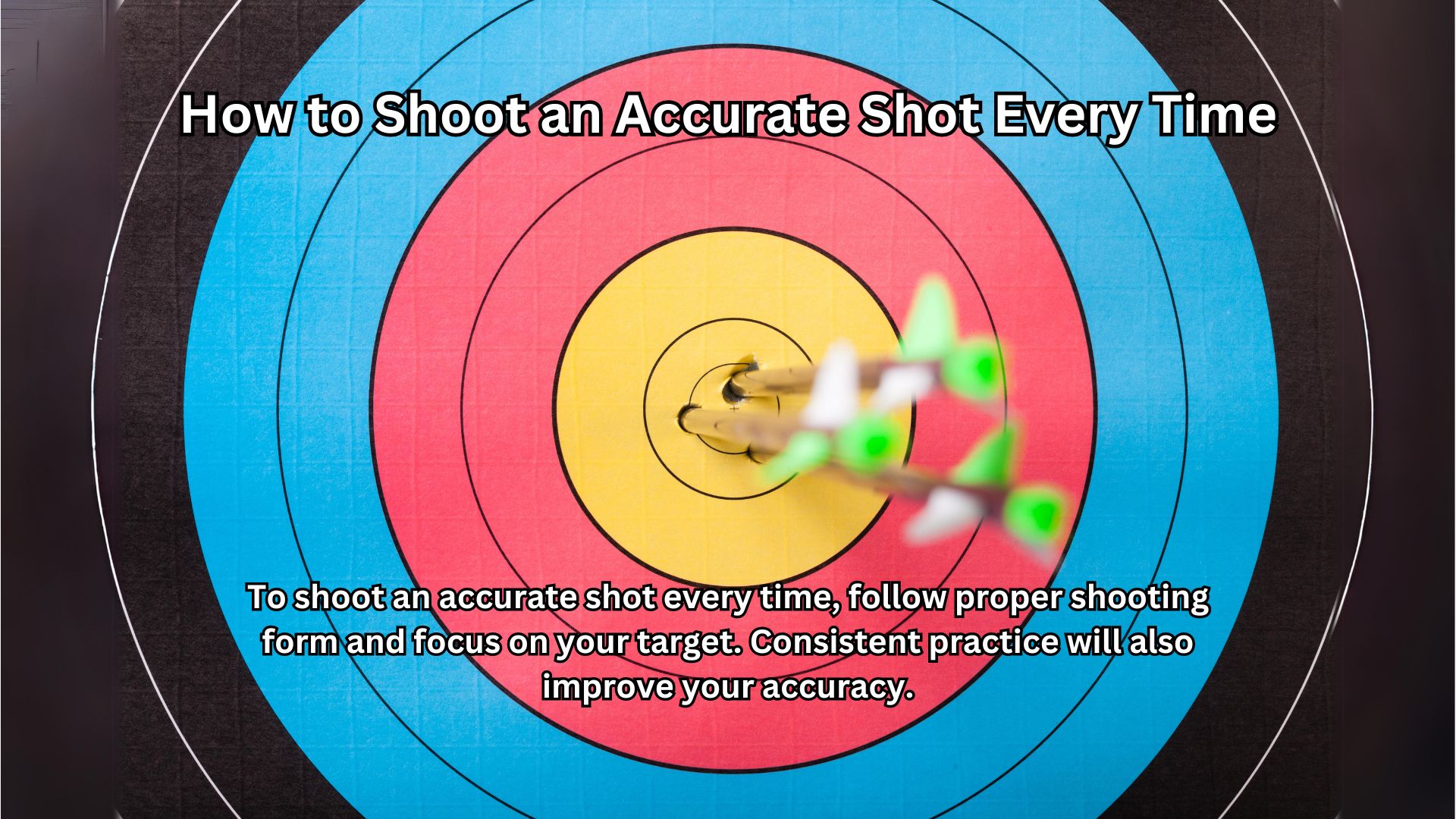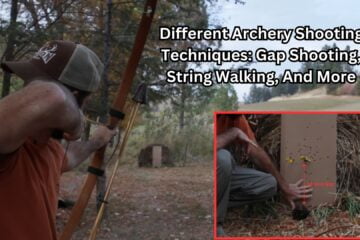To shoot an accurate shot every time, follow proper shooting form and focus on your target. Consistent practice will also improve your accuracy.
Shooting accurately is crucial for any shooter, be it in archery, basketball, or any other sport that requires precision. Whether you’re a beginner or a professional, shooting accurately requires attention to detail and proper technique. The key to hitting your target every time is to focus on proper form.
Proper form not only improves your chances of hitting your target, but it also prevents injuries. Along with proper form, you must also focus on your target and practice regularly to build muscle memory. In this article, we’ll explore the steps you can take to shoot an accurate shot every time, no matter what your skill level is.
Understanding The Basics Of Accurate Shooting
Are you looking to improve your accuracy the next time you go shooting? It all starts with understanding the basics. Keep reading to learn about the importance of a proper stance, grip on the weapon, and correct sight picture.
Importance Of Proper Stance
Your stance plays a crucial role in your accuracy when shooting. Here are some tips to help you establish a proper stance:
- Keep your feet shoulder-width apart for balance
- Position your body square to the target
- Slightly bend your knees for stability
- Lean slightly forward at the waist to distribute your weight evenly
- Avoid locking your elbows or arching your back
Keeping these tips in mind, you can create a stable base for your shot and improve your accuracy.
Grip On The Weapon
Your grip on the weapon is another important factor in accurate shooting. Follow these steps to establish a proper grip:
- Use your dominant hand to hold the grip, with your index finger resting on the trigger
- Wrap your other fingers around the grip, creating a firm grasp
- Keep your wrist locked to ensure a straight and steady shot
By establishing a stable grip, you can better control your shot and improve your accuracy, and you can shoot an accurate shot every time.
Correct Sight Picture
Finally, make sure you have a correct sight picture to ensure an accurate shot. Here are some steps to help with this:
- Align the front sight with the target
- Focus on the front sight post or dot
- Ensure the rear sights are properly aligned with the front sight
By establishing a correct sight picture, you can improve your aim and achieve better accuracy in your shooting.
Remember, accuracy comes with practice and dedication to the basics. By establishing proper stance, grip, and sight picture, you can shoot an accurate shot every time.
Tips To Improve Aim And Accuracy
Shooting is an art that requires precision, focus, and practice. Whether you’re a firearm enthusiast or just looking to improve your shooting skills, having accurate aim is crucial to hitting the target every time. To help you improve your aim and accuracy, we have compiled some essential tips and tricks to make you a sharpshooter.
Importance Of Steady Breathing
Breathing is a fundamental part of shooting, and it is crucial to maintain steady breathing to achieve accurate shots. Here are some ways you can control your breathing to improve your aim and accuracy:
- Take deep breaths before firing your shot to calm yourself down and prevent shaky hands.
- Exhale slowly while squeezing the trigger to avoid flinching, which can affect your aim.
- Practice breathing exercises regularly to increase your lung capacity and maintain a steady aim.
How To Control Trigger Inflection
Trigger inflection is a common issue among shooters that can affect the accuracy of their shots. Here are some ways you can control trigger inflection to improve your aim and accuracy:
- Use the pad of your index finger to pull the trigger instead of the tip to avoid unnecessary movement.
- Maintain a steady grip on the firearm to avoid jerking the trigger.
- Practice dry firing exercises to improve muscle memory and control when pulling the trigger.
Importance Of Follow-Through
Follow-through is an essential aspect of shooting that is often overlooked by beginners. Here are some ways you can ensure proper follow-through to improve your aim and accuracy:
- Continue aiming at the target even after firing the shot to ensure you hit the target accurately.
- Hold your aim for a few seconds after firing the shot to see where the bullet went and adjust your aim accordingly.
- Analyze your shots and adjust your form accordingly to improve your follow-through.
Keep in mind that these tips require practice and patience to perfect. Incorporate them into your shooting routine, and you will see an improvement in your aim and accuracy in no time.
Practicing To Master Accuracy
To shoot an accurate shot every time, you need practice. It doesn’t matter how advanced you are; you must continue to improve your accuracy. Knowing your firearm and its capabilities is critical, but you must also be able to handle and aim it correctly.
Here is how you can improve your shooting accuracy through practice:
Importance Of Dry-Fire Practice
Dry firing refers to the process of shooting your weapon without any ammunition. This method is critical in sharpening your accuracy and identifying your weaknesses. Here are some tips on how to utilize dry-fire practice effectively:
- Make sure your gun is unloaded and all ammunition is stored in a different area before dry firing.
- Pick a target and stand at a comfortable distance.
- Hold the firearm steadily and focus on breathing and control.
- Slowly pull the trigger while aiming at the target.
- Critique your aim, and repeat the process until you can maintain a steady aim.
How To Create A Practice Plan
A practice plan will help you maximize your time and effort while improving your accuracy over time. Here is how you can create an effective practice plan:
- Identify the areas where you need more improvement.
- Consider the amount of time you can dedicate to practice weekly.
- Create a schedule that includes different types of shooting practices, such as dry-fire, range time, and timing drills.
- Stick to your plan and be consistent.
Importance Of Range Time
Range time is the most critical factor in improving accuracy, as it involves the use of live rounds. Here are some ways to use range time effectively:
- Choose the right range facility that meets your needs.
- Use targets specifically designed for improving accuracy.
- Focus on eliminating unnecessary movement while firing.
- Practice your breathing and control techniques.
- Consider taking courses to improve your shooting skills.
Remember, mastering accuracy takes time, effort, and practice. Be patient and persistent in your efforts, and, with consistent practice, you will see significant improvement in your accuracy over time.
Equipment & Accessories To Improve Accuracy
Shooting with precision is a skill that every shooter desires to have. It takes time and practice to improve your shooting accuracy. However, having the right equipment and accessories can improve your chances of hitting your target accurately. We will explore the equipment and accessories that can help you shoot an accurate shot every time.
Choosing The Right Pistol
Your pistol is your primary tool when shooting, so it’s essential to choose the right one. Here are some key factors to consider when selecting a pistol:
- Grip: The pistol grip should fit comfortably in your hand. A good grip provides control and stability of movement.
- Trigger: The trigger’s weight and pull length must be comfortable for you. It should neither be too difficult nor too easy to pull the trigger.
- Barrel length: A longer barrel will typically provide better accuracy, whereas a shorter barrel offers better mobility.
- Caliber: The caliber of your pistol will influence your shooting accuracy. Choose a caliber that suits your shooting purpose.
Understanding Different Sights
Sights are crucial in helping you aim at your target accurately. These are some common types of sights used in pistols:
- Iron sights: These are the most common sights found in pistols. They feature a front post and rear notch that you align to aim at the target.
- Night sights: As the name suggests, these sights use a phosphorescent material that glows in the dark. Night sights are beneficial in low light conditions.
- Red dot sights: These sights use a red dot reticle to help you aim at your target. They are suitable for shooting at longer distances.
Benefits Of A Laser Sight
Laser sights project a laser beam onto your target, making it easy to align your pistol accurately. Here are the key benefits of using a laser sight:
- Improved accuracy: Laser sights enable you to aim at your target more quickly and accurately, especially in stressful situations.
- Better visibility: In low light conditions, laser sights can make it easier to see your target.
- Increased confidence: Using a laser sight can boost your confidence by knowing you’re aiming at your target accurately.
Choosing the right equipment and accessories can significantly improve your shooting accuracy. Consider factors such as grip, trigger, barrel length, and caliber when choosing a pistol. Understand different sights such as iron sights, night sights, and red dot sights. Additionally, using a laser sight can boost your confidence and accuracy while aiming at targets.
Put these tips into practice, and you’ll be on your way to shooting accurately every time!
Frequently Asked Questions On How To Shoot An Accurate Shot Every Time
What Are The Basics Of Shooting Accurately?
To shoot accurately, you must understand your firearm, keep your focus on the target, and steady your stance and grip. Ensure you have good body alignment with the target, squeeze the trigger rather than pulling it, and aim for the center mass.
How Do I Improve My Shooting Accuracy?
Improving accuracy involves developing proper shooting technique and consistency through practice. Train to maintain proper shooting posture, concentrate on the front sight, and work on trigger pull. Consider getting professional coaching, using a shot timer, and shooting from different platforms.
What Can Affect My Shooting Accuracy?
Several factors can impact your accuracy, including lack of training, improper shooting stance, a loose grip, inconsistent trigger pull, or poor vision. Additionally, firearm caliber, recoil, and environmental conditions such as wind and light can all affect your shot placement.
Conclusion
With these effective tips and techniques outlined in this article, you can work towards shooting an accurate shot every time. It’s important to remember that consistency is key, and with practice and dedication, you can develop your skills and improve your shot.
Take the time to focus on your stance, grip, and breathing, and make use of the various aids and tools available to help you achieve your goals. Remember to be patient with yourself, as improvement takes time. With hard work and effort, you can become a skilled marksman, hitting your target with ease and confidence.
Keep practicing, and never give up on your shooting pursuits. By following these guidelines, you will be well on your way to shooting an accurate shot every time.







